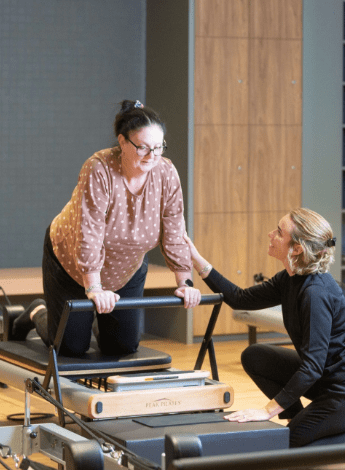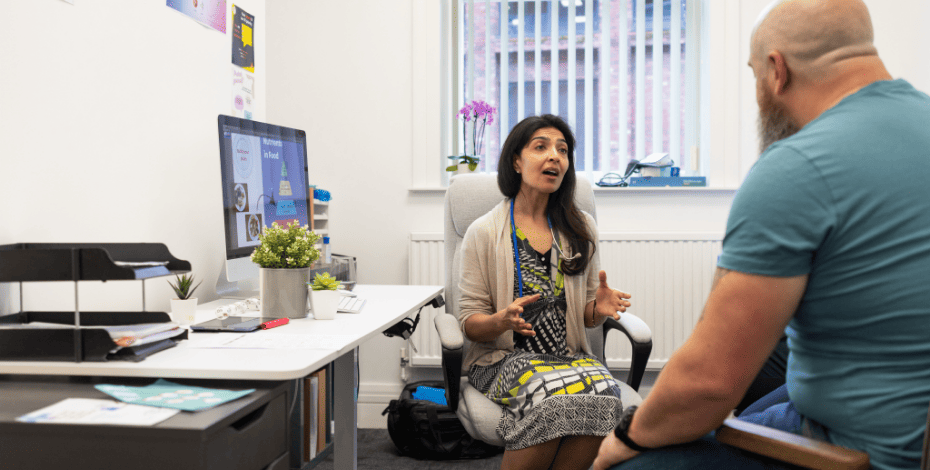
Laneways cuts a clear path for obesity care

A unique multidisciplinary service catering specifically to larger patients and building the capability of healthcare services to provide equitable and excellent obesity care has started up in Melbourne. Founder Nadia Walton says demand for the service has been high.
‘Where do these patients go?’ was a question that played over and over in APA member Nadia Walton’s mind.
As a physiotherapist supporting larger patients through their care journey at Alfred Health in Melbourne, Nadia took note of the challenges faced in providing good care when the equipment, environment and staff skills were designed for smaller sized people.
And she would wonder where her patients would go to find the help they needed once discharged into the community.
These questions troubled her so much that she decided to do something about it.
The result was Laneways Rehabilitation and Ergonomics, a service made up of skilled clinicians who understand the chronic condition of obesity and the challenges that professionals and services experience when providing care to larger people.
Laneways started as a one-day-a-week service that Nadia ran from her home through telehealth consultations and in-home visits, all while continuing to work in public health.
But midway through last year, Nadia realised that she needed to ‘get serious’ about the service and devote her energies to building it up.
‘I’ve only officially been advertising Laneways since October 2023 so we’re really quite new,’ Nadia says.
‘I’ve got a couple of people who contract to me but already we are at a point where we need to get more serious about the business.
'The volume of work is phenomenal, both clinically and in terms of service support.’
With a background in manual handling consultation and clinical education, and having worked in rehabilitation and aged care,
Nadia had engaged with many facets of the profession including public and tertiary services as well as community and private community care.
It was while working in the tertiary setting with larger patients that Nadia began to appreciate the ways in which her skills aligned with supporting them.
‘I originally got into physio thinking I would be able to help people, as many of us do,’ Nadia says.
‘Over the years I started to see that my skills aligned better with supporting bigger patients through their care journey and the value in that.
'Sometimes it means assisting someone who is ventilated and thinking about how we might physically move them, taking into account the emotional support needed.
'And then for the bigger patients who come into rehab, we consider how to rehabilitate them safely and engage them motivationally.’
The decision to open Laneways to cater for larger patients was something Nadia considered deeply and for some time, ultimately creating a business model that focuses on five key aspects of care: providing exceptional clinical experiences, teaching obesity science, advocating size-inclusivity, enhancing physical environments, and safer work processes for patients, organisations and the workforce.
The Laneways team consists of Nadia and senior physiotherapists, an exercise physiologist and a dietitian.
Consultations take place via telehealth or face to face in people’s homes, workplace or the community.
The service provides functional rehabilitation, disability equipment prescription, care planning and motivational support programs to form healthy habits for exercise or community engagement through goal-setting, coaching and education.
If required, Nadia also brokers space at allied health clinics so that she or team members can meet with patients face to face in an environment that better enables success.
‘Firstly, at Laneways we meet people where they are; we are not a weight loss service.
'Significant weight loss doesn’t come from exercise; that’s not the purpose of what we do,’ Nadia says.
‘We offer a kind service to larger people—that’s our metric—and we meet them at the goals they want to achieve.
'If they come to us and don’t want to talk about their weight, we don’t talk about their weight; that’s not our agenda.
'It’s about saying, “We value you as a person and recognise that maybe you have had some stigmatising experiences with healthcare. You are not going to get that from us.”’
Branding herself as a physiotherapist and an obesity care consultant, Nadia has set Laneways up as an ally to larger people, creating a safe space for her patients, many of whom have experienced weight stigma from previous healthcare interactions.
Patients are referred to Laneways from other health professionals or they learn about it from other health services. Some reach out directly for help.
All patients are assisted with goal setting and the goals vary from one patient to the next.
‘We might have a patient who says “I’d like to do karate but I’m going to sweat too much; I’m going to breathe too heavily; the gear is not going to fit me; how will I go with an hour of exercise?
'What do I do with chafe? What clothes do I wear? How do I manage big boobs?” Things like that.
'A lot of our work is coaching someone and assisting with getting them ready to manage the exercise or movement they want to do,’ Nadia says.
The service also facilitates equipment scripting for those who come to it through the National Disability Insurance Scheme.

Nadia treats a patient as part of the service at Laneways. Photo: Socialise Photo/Michael Rees-Lightfoot
For the physiotherapists on the team, the work involves assisting patients with pain relief, helping them in active recovery and using stepping stones to help patients engage with ‘enjoyable exercise’.
The clinic also offers support to the carer or family of the patient during their care journey at Laneways.
The clinic is proactive with patients about their obesity-related complications.
Maintaining direct contact with the patient’s GP where necessary, as well as having direct lines of communication about common conditions such as diabetes or cardiovascular disease, is a top priority.
Nadia says working in this complex space means that the clinicians on the team are all senior practitioners, well versed in navigating multidisciplinary care.
‘One in three Australians are overweight or obese and of those, about 80 per cent have experienced stigmatised healthcare,’ Nadia says.
‘A significant proportion of them will then avoid healthcare.
'We have created a safe space for our patients to tell us what they want and how they want it; we don’t expect people to change if they don’t want to change.’
Nadia also shares her knowledge and expertise on how to operate an obesity-friendly service through training sessions with other healthcare providers, corporations and community organisations.
The training covers topics such as how to discuss a patient’s weight effectively, weight stigma and size inclusivity, supporting a bigger workforce and how to be an ally with the plus-size community.
‘I will also work with services to review their policies, practices, environment and staff training programs, asking questions such as “Can you provide equitable clinical care? Is your waiting room size-inclusive? Are your treatment strategies size-inclusive?
'If you do need to know someone’s weight, how are you going to do that carefully and with respect? If you are going to ask people to undress, what sort of draping or gowns might you need?
'How do you have sensitive conversations about the impacts of someone’s size on their presenting condition?”
'From that we develop a range of policies, procedures, skills, equipment and environmental improvement plans in relation to how you might make sure your staff and service are offering clinical excellence,’ Nadia says.
Tips for clinicians with bigger patients
• Assess the specific equipment needed to carry out your job, considering patient vulnerability when appropriate tools aren’t available. Examples include gowns, draping towels, tourniquets, blood pressure cuffs, long needles and long- handled shoe horns.
• Explore alternate treatment positions if standard equipment is inadequate or if patients can’t assume typical positions like lying flat or face down.
• Be mindful of how you communicate equipment, service or skill shortcomings, focusing on your shortcomings rather than attributing blame to patients’ size.
• Consider the where, when and how of measuring patient weight, recognising the sensitivity of this moment in building or potentially fracturing therapeutic relationships.
>> Nadia Walton uses the word ‘obese’ as common medical language to convey her expertise with larger bodies. However, she acknowledges that it may be perceived as stigmatising to some people and she affirms that she works to reduce weight bias.
© Copyright 2025 by Australian Physiotherapy Association. All rights reserved.





